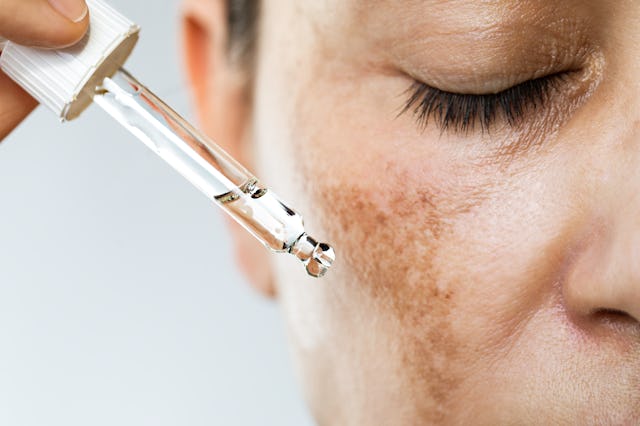How To Get Rid Of That D*mn Melasma, According To An Esthetician
Won’t miss ya, melasma.

As I was going through pregnancy, there were a lot of unpleasant side effects I had prepared myself for during and after. Stretch marks, postpartum hair loss… it's not as if I was looking forward to these things, but I at least knew they were coming. What I was not expecting was my first-ever experience with melasma, which appeared on my face as a permanent 5 o'clock shadow-style mustache across my upper lip.
I soon learned that a few friends and family members had gone through something similar, and we all commiserated on the fact that some of the most effective treatments for it were (of course) not safe during pregnancy or breastfeeding. So, what can you do about this pesky side effect?
I spoke with Audrey Ford, a licensed esthetician at The Spa at Selenite in Charlotte, North Carolina, about melasma: what it is, how you can safely treat it during pregnancy, and what you can do to get rid of it once and for all after.
What is melasma?
According to the American Academy of Dermatology, "Melasma is a skin condition that causes patches and spots, usually on the face, which are darker than your natural skin tone." While several factors can cause melasma, from exposure to sunlight to certain medications, one of the common causes is due to hormones — making pregnancy a common time for people to experience melasma.
"Melasma is triggered during pregnancy and postpartum by increased hormonal changes, which stimulate increased amounts of melanin that your body produces," Ford explains. "Melasma is also sometimes referred to as a 'pregnancy mask' because the splotches typically appear around your upper lip, nose, cheekbones, and forehead."
How can you treat melasma during pregnancy and breastfeeding?
Melasma commonly occurring during pregnancy is particularly cruel because many typical treatments for it are considered unsafe to use while pregnant or breastfeeding. So, what can you use to help prevent melasma while pregnant or breastfeeding?
"A mineral (physical/non-chemical) SPF of 30 or higher daily is the most important preventative step," Ford explains. "Sun, heat, and exposure to pollution can trigger melasma and intensify the darkening pigment."
Ford also recommends pairing low concentrations of Vitamin C, which "pair[s] well with SPF daily to protect the skin against environmental damage and free radicals." Additionally, pregnancy and breastfeeding-safe AHA exfoliants can be effective in correcting and brightening pigmentation at a higher level, including lactic, glycolic, mandelic, and kojic acid.
For example, you could use a product like the Zemits ClearJoy Mandelic Acid Serum, a gentle serum formulated with mandelic acid and lactic acid to treat hyperpigmentation. The gentler formula is also ideal for pregnancy and postpartum when you still need to avoid products like retinol or hydroquinone.
Of course, Ford points out that “Before using [any] products during pregnancy, you should consult with your health or wellness professional.”
What are the best treatments for melasma post-breastfeeding?
Once you’re no longer breastfeeding, your options for melasma treatment can become much more expansive, opening up to ingredients that may not have been safe or advised to use while pregnant.
“Post-breastfeeding, your body will more safely tolerate higher concentrated corrective ingredients and treatments,” Ford says. “Higher percentages of exfoliating acids and BHA exfoliators like salicylic can offer a more intensive exfoliation and more effectively target postpartum acne and breakouts contributing to uneven pigment.”
Another product that can make a big difference? Retinol. Retinol is a derivative of vitamin A, which plays a key role in cell regeneration. In other words, it increases your skin cell production, which is vital with something like melasma. Retinol will “speed cell turnover to even skin tone, target texture, dark spots, and scarring,” according to Ford.
For a powerful Retinol that will still keep your skin hydrated, opt for a Retinol face oil like the MARA Algae Retinol Face Oil. The formula has 1.2% Retinol, along with more soothing ingredients like green tea and algae extracts.
Deeper professional treatments are also an option, with Ford recommending chemical peels and facials to accelerate those results. And just like you needed to wear sunscreen for skin protection during pregnancy, it's just as crucial for fighting (and preventing the return of) melasma afterward.
Melasma treatment takes time.
My journey with melasma is still ongoing. Post-breastfeeding, I took Ford's advice, tried out a chemical peel (shout out to the life-changing VI Peel), and visited my dermatologist for some prescription-level treatments. It's been well over a year since my melasma mustache made its (unwelcome) appearance, and only now has it started to really go away.
In the grand scheme of life, the rational part of me knows melasma isn't that big of a deal. It's not harmful to my health or my child's health, and in many cases, treatment and time will help it go away. But I'd be lying if I said it didn't affect my self-esteem and how I looked.
If you are concerned about the appearance of any pregnancy-related melasma, you can speak with an esthetician or dermatologist about your treatment options.
And in the meantime, make sure to load up on sunscreen, even on cloudy days — there's nothing more important you can do for your skin than protect it.
This article was originally published on